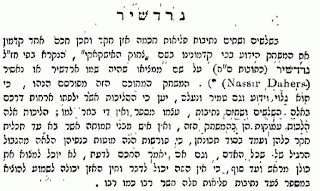 |
| Credit: see below. |
Another early mention of chess in the Hebrew-language press is -- again -- HaZefira. On April 27th, 1880 (p. 7), S. Chervhevesky from Odessa [phonetic spelling of the Hebrew שערשעווסקי -- clearly a Polish name, but I am probably mis-transcribing it]. The author notes that chess is called in Hebrew nardshir, based on the mention of a game by that name the Talmud, which Rashi (Rabbi Shlomo Yizhaki, whose commentary on the Talmud appears in most editions of it) translates as "chess" [Ishkakish, a corruption of the French echecs] in the Ketubot tractate, p. 61.
The article describes the pieces, the board, some poetry mentioning chess, the old legend about the Indian sage who asked the king, as a reward, for one grain of wheat on the first square, doubling every square, and so on. It is notable for two reasons.
First, the author does not mention a queen, but a vizier [משנה למלך], as in the Arab game. Second, the editor, in a footnote, disagrees with the author's claim that nardshir is chess. The reason given? Not any knowledge of chess' history (i.e., the that game was invented in India in the 6th century at the earliest, long after the Talmud's time), but that nardshir is mentioned in the Talmud in the context of a man who complains that his wife plays nardshir excessively, so the editor claims surely the game cannot be chess, but probably "some sort of easy game women like to play".
I wonder what Susan Polgar would say about that.

